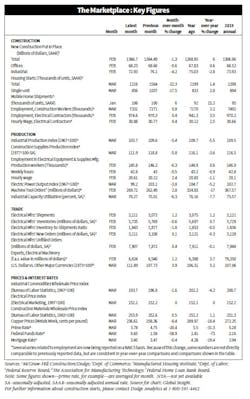Key Figures and Leading Economic Indicators: April 17, 2020
Freight rail traffic continues dramatic decline. The Association of American Railroads (AAR) reported that for the week ending April 4, total U.S. weekly rail traffic was 429,095 carloads and intermodal units, down -15.9% compared with the same week last year. Total carloads for the week ending April 4 were 210,911 carloads, down -16.2% compared with the same week in 2019, while U.S. weekly intermodal volume was 218,184 containers and trailers, down -15.7% compared to 2019.
“The impact of the novel coronavirus on railroads is growing,” said AAR Senior Vice President John Gray, in the press release. “Part of the problem now is sustained weakness in coal carloads, but even excluding coal, carloads last week were down -13.1%. We haven’t seen sustained declines of that magnitude since the Great Recession.
“Intermodal volume last week was down -15.7% over last year,” Gray added. “With China in the very early stages of its own recovery, whether intermodal volumes will continue to fall — and if they do continue to fall, how far — will now depend to a large extent on what happens with consumer spending in North America.
March construction data is in but doesn’t yet reflect full impact of COVID-19. On the surface a -5% monthly drop in total construction start data published this week by Dodge Data & Analytics doesn’t sound all that awful, but Richard Branch, the company’s chief economist, says the April data will be a more accurate reflection of the impact of the crisis on the construction market.
“Considering the calamity that occurred towards the end of March as the fallout from the COVID-19 coronavirus hit the economy, construction starts held up rather well,” said Branch in the press release. “Construction starts in March were unlikely to be greatly impacted as projects that broke ground during the month likely had materials sourced and in-place and labor booked well ahead of the scheduled groundbreaking. That momentum and planning is difficult to reverse at the last minute. Additionally, most of the stay-at-home orders and construction moratoriums were not
instituted until the last week of the month and into April. Therefore, April construction starts are likely to be a very different story with states like New York, New Jersey and Pennsylvania among others banning construction activity. April’s starts data will be the first true indication of how the crisis will impact the construction industry.”
The Dodge press release said total construction starts declined -5% from February to March to a seasonally adjusted annual rate of $746.9 billion. According to Dodge. Volatility caused by the presence or absence of large projects in healthcare and the utility/gas plant category, however, skewed the analysis. In March, nonresidential building starts fell -9% from February (seasonally adjusted), while residential building dropped -11%.

